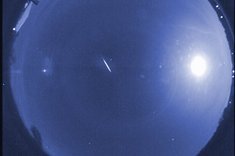While the Taurid meteor shower doesn’t have a lot of shooting stars to offer, the few that will streak across the sky in the coming days will be bright, spectacular fireballs. The North Taurid meteor shower is at its peak now!
Skywatchers in the Northern and Southern Hemispheres will have two different peak viewing times. But the estimated dates have some wiggle room, because meteor rates will be consistently low throughout the meteor shower. Typically, the Taurids produce only a handful of visible meteors per hour.
In 2017, the North Taurid meteor shower will peak overnight on Nov. 11-12 for viewers in the Northern Hemisphere. In the Southern Hemisphere, the South Taurid meteor shower peaked overnight on Oct. 10, according to the American Meteor Society . However, viewers in both hemispheres can still see meteors through late November.
The Taurids are associated with Comet Encke. As this object orbits the sun, it leaves a trail of comet crumbs in its wake. In some years, when Jupiter’s orbit brings it close to the comet’s trail, the gas giant’s gravity nudges the comet particle stream toward Earth, so more meteors are visible to observers here. Astronomers call this an “outburst.” That isn’t expected to happen this year, but the latest predictions suggest that an outburst will happen in 2019, NASA meteor expert Bill Cooke told Space.com.
Most meteor showers come from tiny fragments that burn up in Earth’s atmosphere, but calculations indicate that Comet Encke’s debris could produce meteors big enough to survive the trip to the ground. These meteorites have not been discovered yet, Cooke said, adding that such a discovery would be a “holy grail of meteorites.” No one knows how big a Taurid meteorite might be, but Cooke said the comet chunks are estimated to weigh a few ounces.

0 of 10 questions complete
When to see them
Cooke said that it can be hard to pick the best day to look for the Taurids, because the meteor shower is visible for several weeks. The best results will happen in the early morning (just before dawn) from any dark location. On peak viewing days, there may be only a few more meteors per hour than on other days, so the difference is hardly noticeable, he said.
“The rates are low, so be prepared to look for a while,” Cooke said.
Observers may also spot some stray shooting stars that are unrelated to the Taurids. These will appear to originate somewhere other than the constellation Taurus and will travel in random directions through the night sky. Moonlight won’t overly interfere with the peak of the northern Taurids, but watch for it at other times around the peak (and try to time your observations for when the moon is not in the sky).
The Northern Taurids run from October 19th to December 10th annually. The weak shower, with only 5 meteors per hour at the peak, is derived from material left by the passage of periodic Comet 2P/Encke. The debris’ larger than average grains often produce colorful fireballs. Watch on Saturday evening, before the last quarter moon rises.
Credit: SkySafari App
Where to look
The Taurids are visible practically anywhere on Earth, except for the South Pole. They appear to originate in the constellation Taurus the bull . To find Taurus, look for the constellation Orion and then peer to the northeast to find the red star Aldebaran, the star in the bull’s eye .
Don’t look directly at Taurus to find meteors; the shooting stars will be visible all over the night sky. Make sure to move your gaze around the nearby constellations. Meteors closer to the radiant have shorter trails and are more difficult to spot. If you look only at Taurus, you might miss the shooting stars with the most spectacular trails.
What causes the Taurids?
The Taurids come from Comet Encke , a short-term periodic comet that orbits the sun about once every 3.3 years. It was first spotted by Pierre Mechain in 1786 and was first recognized as a periodic comet in the 1800s by Johann Franz Encke.
Comet Encke is about to make a close pass with the sun at the end of November. Image uploaded Nov. 11, 2013.
Credit: NASA
As the comet moves around the solar system, it leaves behind bits of material that are called meteoroids. If those comet chunks enter the Earth’s atmosphere, they are called meteors. The friction they encounter while speeding through the Earth’s atmosphere heats them up, sometimes making them visible from the ground. Those chunks that reach the ground, if ever discovered, would be called meteorites.
How to get the best view
Meteor showers require no special equipment to view. Just travel to an area that has few lights, away from major cities. Get comfortable on your back, staring straight up at the sky. This will let you view more meteors than by staring in one direction.
Follow Elizabeth Howell @howellspace , or Space.com @Spacedotcom . We’re also on Facebook and Google+ . Original article on Space.com .

Comments are closed.